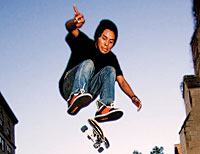Celebrate the Vibrancy of American Indian Skateboarding Culture in New Smithsonian Traveling Exhibition
Skateboarding is one of the most popular sports on Indian reservations and has inspired and influenced American Indian and Native Hawaiian communities since the 1960s. A new exhibition from the Smithsonian Institution Traveling Exhibition Service, together with the National Museum of the American Indian, celebrates the vibrancy, creativity and history of American Indian skateboarding culture.
“Ramp It Up: Skateboard Culture in Native America” will open April 28, 2012, at the San Diego Museum of Man in San Diego, and features 20 skate decks, including examples from Native companies and contemporary artists, rare images and video of Native skaters. The exhibition will be on view through Sept. 9, 2012, before continuing on its 12-city national tour. “Ramp It Up” was previously on view at the Smithsonian’s National Museum of the American Indian in New York, as well as at the National Museum of American Indian in Washington, D.C.
Exhibition highlights include a never-before-exhibited 1969 image of a skate deck depicting traditional Native imagery, taken by skateboarding icon C.R. Stecyk III, and 1973 home-movie footage of Zephyr surf team members Ricky and Jimmy Tavarez (Gabrielino-Tongva).
“Skate culture is a great lens to learn about both traditional and contemporary Native American culture,” said Betsy Gordon, curator of “Ramp It Up.” “This exhibition not only showcases the Native skater but also the Native elders, parents, government officials and community activists who have encouraged their kids to skate.”
The exhibition features the work of visual artists Bunky Echo-Hawk (Yakama/Pawnee), Joe Yazzie (Navajo), Traci Rabbit (Cherokee Nation of Oklahoma) and Dustinn Craig (White Mountain Apache/Navajo) and highlights young Native skaters such as 22-year-old Bryant Chapo (Navajo) and 13-year-old Augustin and 10-year-old Armondo Lerma (Agua Caliente Band of Cahuilla Indians).
As skateboarding continues to rise in popularity in Indian Country, Native skaters and entrepreneurs have combined core lessons learned from the sport—strength, balance and tenacity—with traditional tribal iconography and contemporary art to engage Native youth in their history and culture. “Ramp It Up” examines the role of indigenous peoples in skateboarding culture, its roots in ancient Hawaiian surfing and the visionary achievements of contemporary Native skaters. Skateboarding combines demanding physical exertion, design, graphic art, filmmaking and music to produce a unique and dynamic culture. “Ramp It Up” illustrates how indigenous people and tribal communities have used skateboarding to express themselves and educate their youth.
SITES has been sharing the wealth of Smithsonian collections and research programs with millions of people outside Washington, D.C., for almost 60 years. SITES connects Americans to their shared cultural heritage through a wide range of exhibitions about art, science and history, which are shown wherever people live, work and play. Exhibition descriptions and tour schedules are available at www.sites.si.edu.
The Smithsonian’s National Museum of the American Indian is the first national museum dedicated to the preservation, study and exhibition of the life, languages, literature, history and arts of the Native peoples of the Western Hemisphere. Established by an act of Congress in 1989, the museum works in collaboration with Native peoples and communities to protect and foster their cultures by reaffirming traditions and beliefs, encouraging contemporary artistic expression and empowering the Native voice, (www.AmericanIndian.si.edu).
# # #
SI-513-2011



